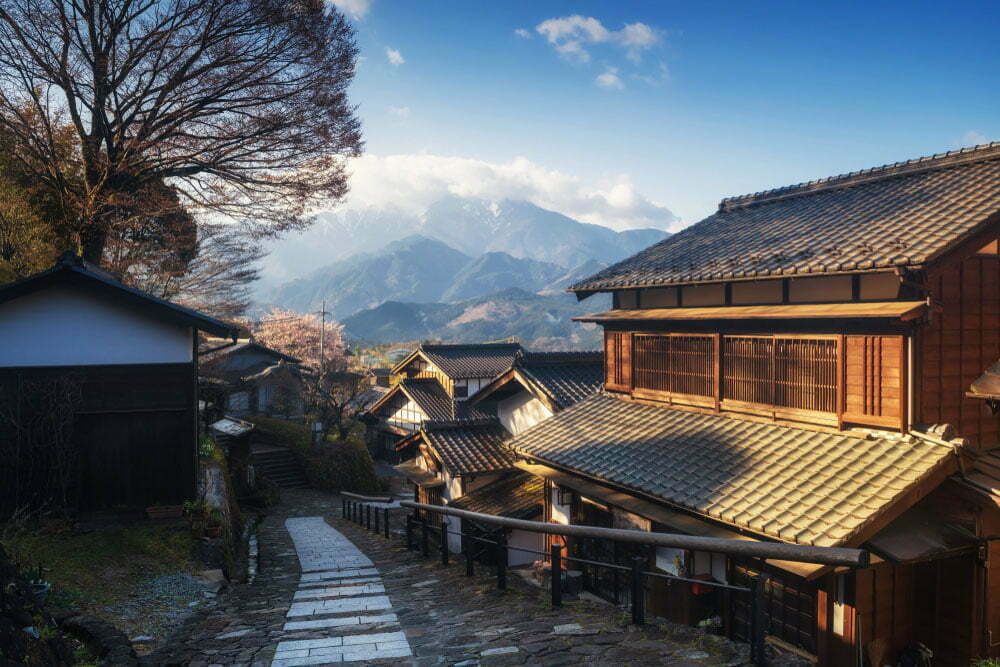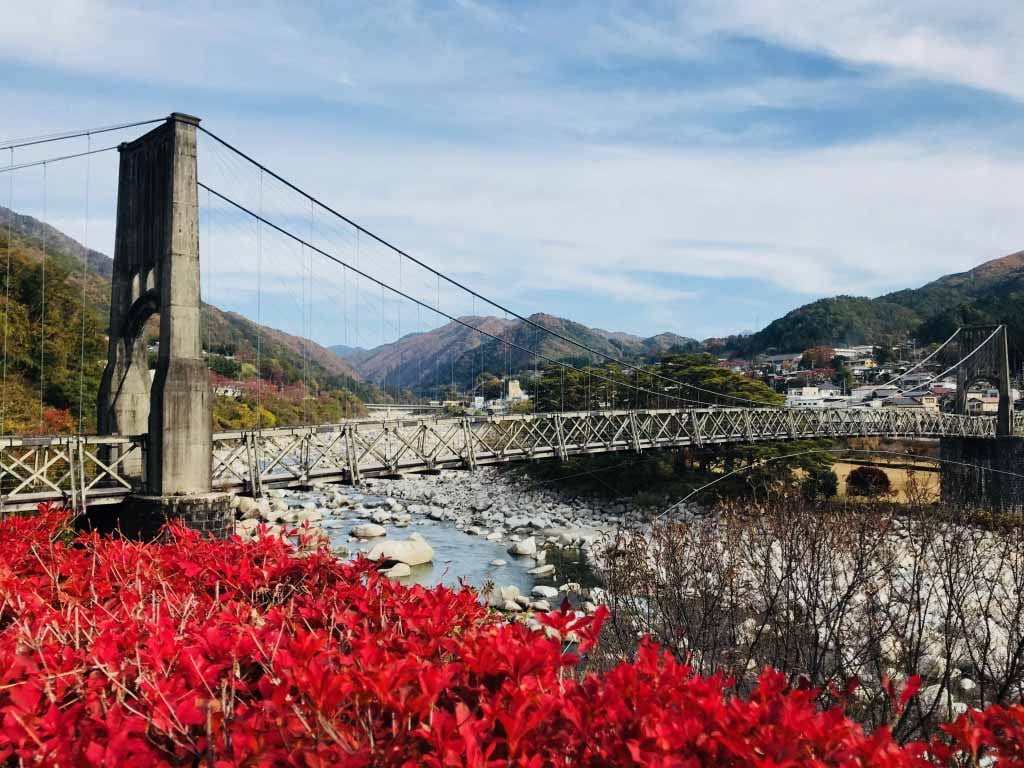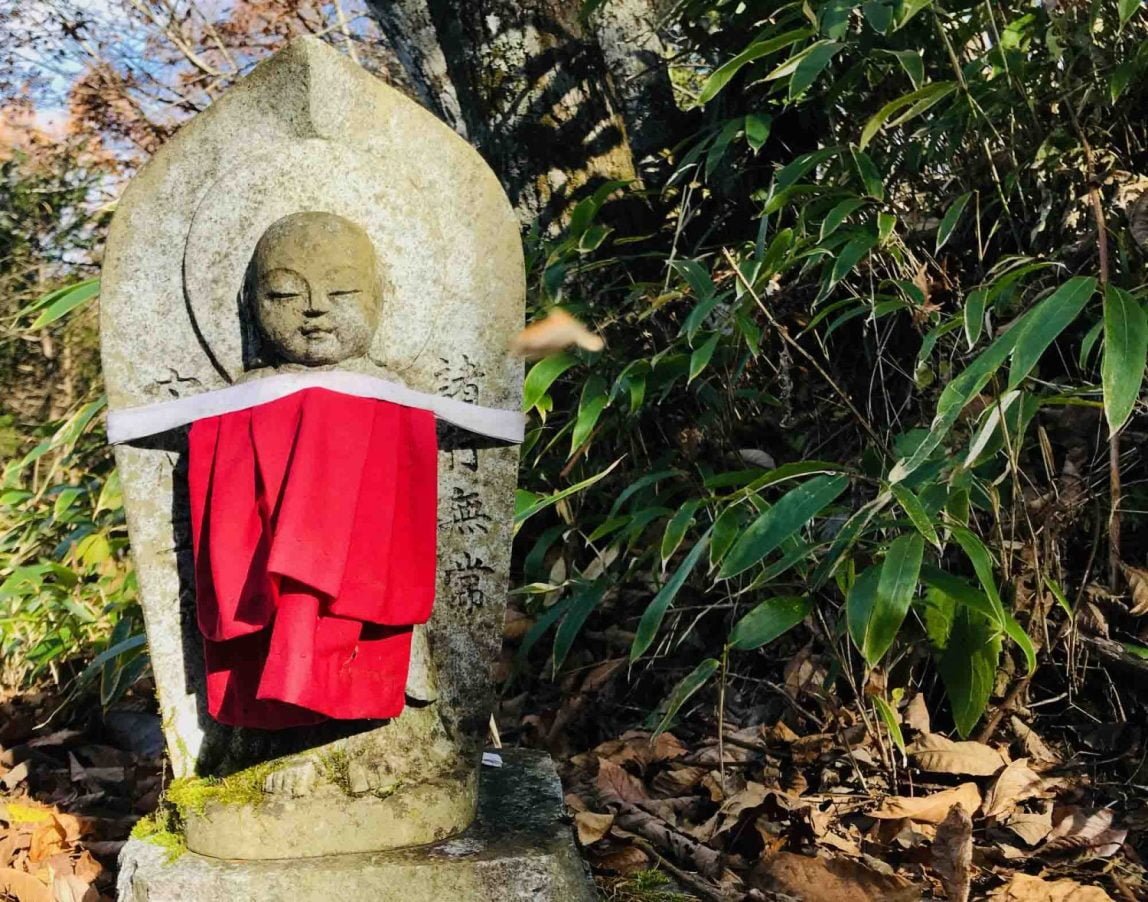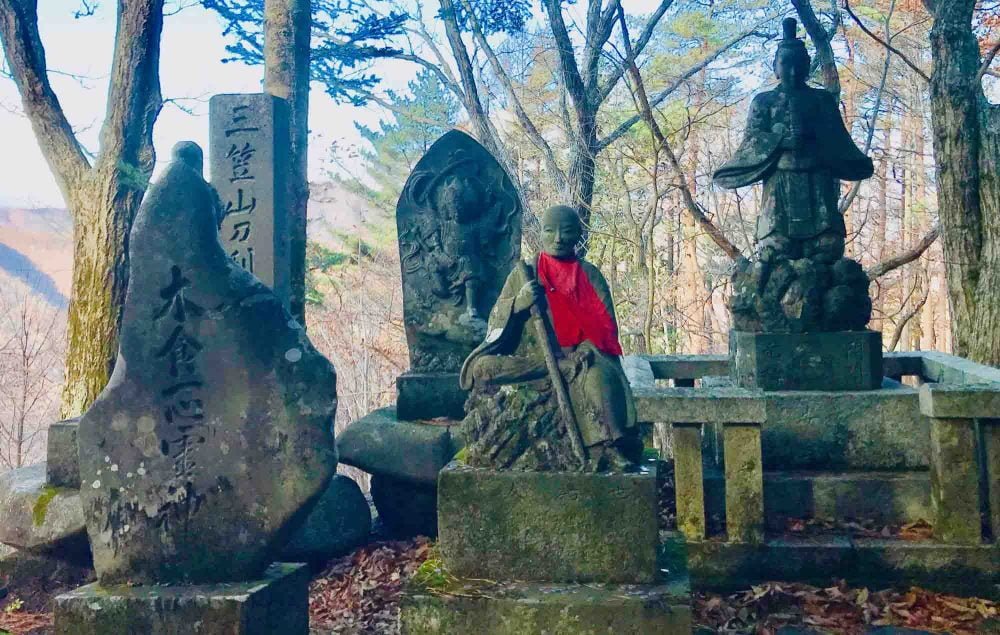 30 years' experience providing walking holidays worldwide
30 years' experience providing walking holidays worldwide-
SELF-GUIDED
-
6 DAYS
-
Moderate
OVERVIEW
OVERVIEW
The Nakasendo Way, connects Edo (Tokyo) and Kyoto via a mountainous inland route, featuring a network of 69 post towns spread along 540km. The section through the Kiso Valley was known as the Kiso-ji or the Kiso Road. There were 11 post towns in the Kiso Valley. The 27km section that connects the four southernmost towns (Magome, Tsumago, Midono [Nagiso], and Nojiri) has become a very popular hiking trail in recent years. On this walk, we have added the gorgeous walk up to the Kaido Plateau, in our estimation, one of the best walks in the region.
The Kiso-ji is a hilly path of ancient stone pavements and dirt trails that will lead you through landscapes alive with seasonal flowers, clear-water creeks, and tall old forests. Countless daimyo processions, including samurai, farmers, merchants, and others, travelled along the road during the Edo Period of the 1600s and beyond.
HIGHLIGHTS:
- Experience the Kaido Plateau, one of the best walks in the region
- An itinerary enabling you to walk the Nakasendo with options to shorten some days
- Walk pack free on well-graded ancient trails, with wondrous views, through old forest and bathe in onsens
- The impressive Karasawa Waterfall and the famous Torii Pass
- Incredible mountain views
- Enjoy authentic Japanese dinners and breakfasts served in mostly elegant tatami mat settings, served at your traditional Japanese accommodations
ITINERARY
WHAT’S INCLUDED
- Explore the beautiful Kaida Kogen Plateau in hills north of Kiso-Fukushima
- Walk with a light pack, with luggage transfers most days from accommodation to accommodation (please see Luggage Transfer section in General Info for details)
- 5 nights stay in an intimate family-run or small traditional Japanese accommodation
- Superb traditional multi-course meals for breakfast and dinner each day
- Itineraries can be flexible to shorten the walking or slow the trip down by adding more rest days
- Enjoy worry-free navigation with Stroll’s comprehensive track notes and maps
- On the ground support from local representatives
ACCOMMODATION & DINING
You will spend each night in a traditional Japanese Minshuku or Ryokan-style accommodation. These Japanese guesthouses come in a number of styles ranging from traditional wooden structures to more modern hybrid hotels.
A Minshuku is a family-run accommodation that are often found in rural Japan. There is a fine line between a Minshuku and some smaller Ryokans, making it hard to distinguish between the two. Most Minshukus are very small, with only a few Japanese-style rooms, a bit like a Bed and Breakfast Japanese style. Staying at a Minshuku has its advantages, as it is a good chance to meet the local people and get right up close to the Japanese culture. The atmosphere is often like that of a home with traditional meals served much like at a Ryokan but with even more intimacy. Be prepared, as baths and toilets are often shared.
Ryokans have Japanese-style rooms with tatami mats, shoji sliding doors, and futons for sleeping on. Few Ryokan Hotels have rooms with actual beds. The rooms may or may not have ensuites, but be prepared for a little luxury when it comes to the heated toilet seats. The bathing area is often the pride of the Ryokan, especially when they’re located in an onsen area. These are usually communal and separated by gender.
Meals are elaborate affairs from a western point of view served in a traditional dining area. A traditional Kaiseki set meal is what is usually offered. Sometimes there is the option of a buffet at the larger Ryokans.
Please note that we will endeavour to book the accommodation displayed. However, if unavailable, we will book alternative accommodation at the same standard.
GENERAL INFO
TRAVEL TO NAKATSUGAWA
Tip – if you have not invested in a JR Rail Pass (only available outside Japan), you can save some money by buying a Non-Reserved Seat on the Shinkansen rather than a Reserved Seat. Check the Japan Transit Planner website (https://world.jorudan.co.jp/mln/en/) for approximate travel times and pricing.
You can get tickets from the JR ticket window just before the Shinkansen barrier gates. Even if you have a JR Rail Pass (which covers the cost of all JR line travel), you will need to show some sort of ticket to indicate your seat.
TRAVEL FROM TOKYO TO NAGOYA
Take the Tokaido Line Shinkansen bullet train from Tokyo Station to Nagoya.
Approx. travel time 1hr 45mins.
Tip – try to get a window seat on the right-hand side of the train for possible views of Mt Fuji on a clear day.
TRAVEL FROM OSAKA TO NAGOYA
Take the local train from Osaka to Shin-Osaka. Take the Tokaido Line Shinkansen bullet train from Shin-Osaka Station to Nagoya. Approx. travel time 48mins.
TRAVEL FROM NAGOYA TO NAKATSUGAWA
On arrival in Nagoya, take the JR Chuo Line (Rapid) from Nagoya to Nakatsugawa. The Rapid service stops less often than the Local service. Both are of the same price and stop in Nakatsugawa. Approx. travel time 1 ¼ hr. Cost (if no JR Rail Pass).
The free “Japan Direct” rail app is very useful. Enter your station of origin and destination and all services, travel times, and costs are displayed. There is also an option to select for routes when travelling “with Japan Rail Pass”, too.
HIGH SEASON
In Japan, there are some periods when locals travel en masse as they are on holiday. These times are best avoided as the accommodation costs escalate considerably (more than double). It would make a lot of sense if you could avoid these times. Otherwise, see below for high-season periods. This could lead to the cost of the trip increasing significantly.
NEW YEAR PERIOD – 30TH DECEMBER TO 4TH OF JANUARY
GOLDEN WEEK – GENERALLY BETWEEN 29TH APRIL TO 5TH MAY
OBON PERIOD – MID-AUGUST ( BETWEEN THE 10TH TO 20TH OF AUGUST)
Please speak to the office to get a quote for the above times
DEPARTING FROM YOKOKAWA OR KARUIZAWA TO TOKYO
DEPARTING FROM YOKOKAWA OR KARUIZAWA TO TOKYO
At the end of your holiday, you will have details for travelling back to Tokyo from either Yokokawa Train Station or Karuizawa by train.
PUBLIC TRANSPORT
On this walk, you will need to catch some buses and have the option of catching them to shorten some walk days also. Most of these rides will be very short. You won’t be able to pre-book any of these rides but catching them on the day is a seamless process. These bus fares are at your own cost.
LUGGAGE TRANSFERS
This walk has the luggage transferred most days; we will let you know when we can’t move the bags due to the remoteness. The luggage will be waiting for you at the following accommodation. In the evenings, you will be supplied with a yukata (Japanese Gown) to wear so you will need to carry only essential items on those days when your luggage isn’t available.
AVAILABILITY
Autumn and Spring are the best times to walk. Summer is good too, it can get warm but it is possible to take a swim as you walk. Winter can be a bit more challenging due to snow and less daylight hours but it is still possible. You will need snow gear. Please keep in mind some accommodations close down from late November to February.
WEATHER
From the end of March, the temperature begins to increase. In summer it’s quite warm and humid but still good for walking, particularly if you enjoy warmer temperatures and taking a dip in a stream.
The walk is offered in winter but bring some warm clothes and good rain gear. The area is just as beautiful if not more and is not busy at all. Soaking in outside onsen in the cool of the night is one of those real authentic Japanese experiences that you can look forward to after a big day on the track.
As walkers, we believe spring and autumn to be the best time as the weather is perfect for walking.
See the weather information about the local average weather at different times of the year.
INSURANCE
We require that you have adequate travel insurance against potential losses, damage or injury, including cancellation costs and loss of luggage.
For all trips that require international travel, you must have purchased travel insurance that also includes medical evacuation coverage.
We also charge a cancellation fee if you cancel your walking holiday after we have confirmed it to cover costs incurred from our suppliers and in the office. See the FAQ section for more information.
INFORMATION PACK
For nearly 30 years we have taken pride in providing seamlessly organised walking holidays, but we know, even with that in mind, that you’ll have many more questions. You will receive a very detailed information pack and itinerary approximately 6 weeks out from departure outlining all the fine detail and much more.
CONTACT
If you have any questions, feel free to ask one of our destination consultants. You can get in touch with us via our contact form or email us at info@stroll.com
MAP
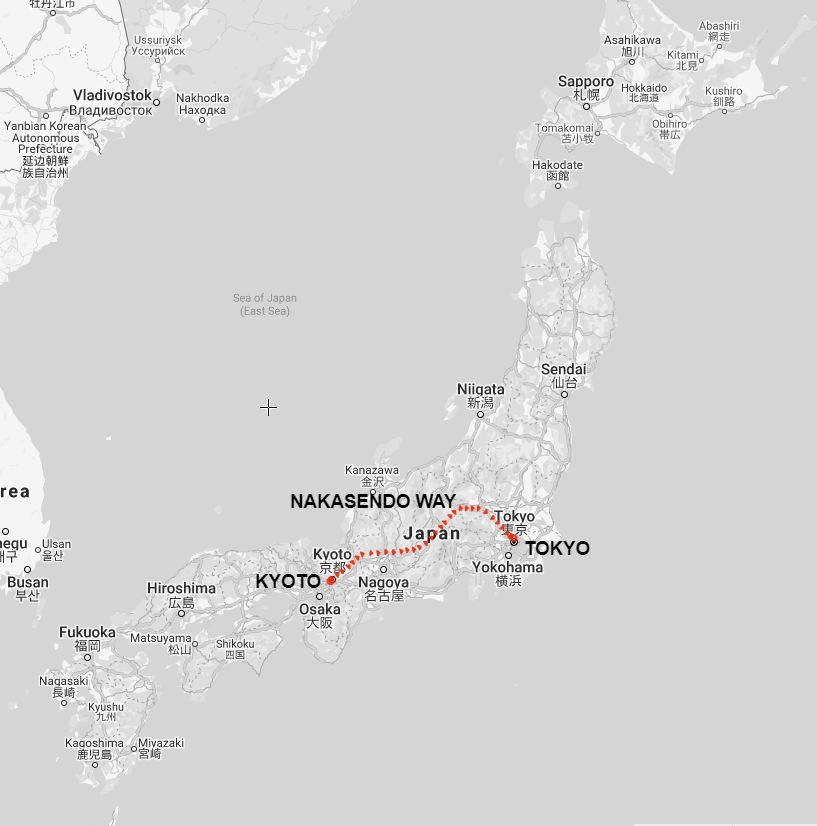
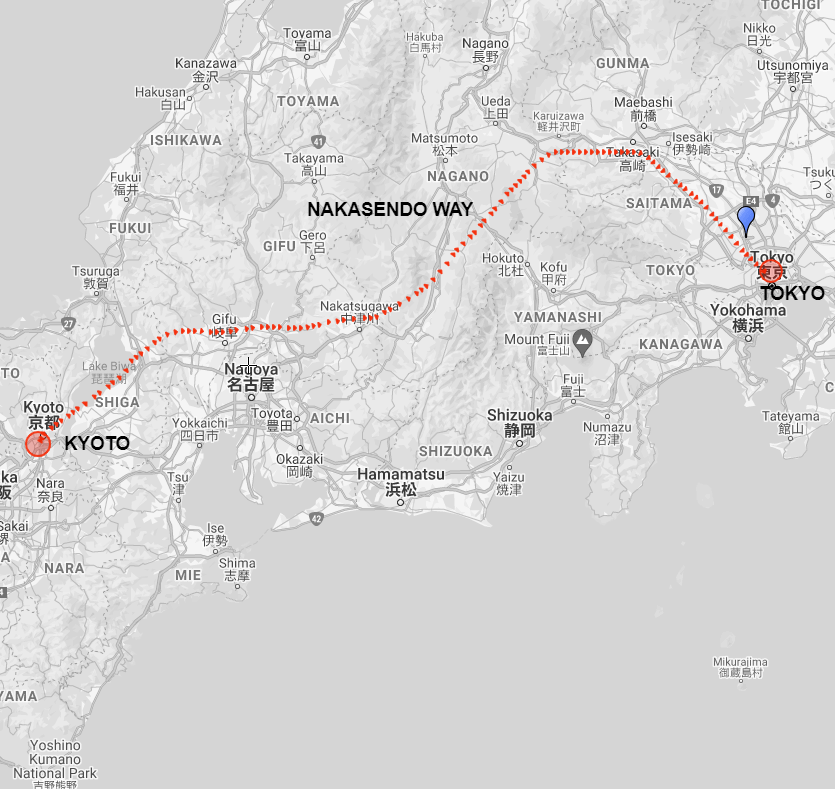
DEPARTURE DATES
sections
The Nakasendo Way, connects Edo (Tokyo) and Kyoto via a mountainous inland route, featuring a network of 69 post towns spread along 540km. The section through the Kiso Valley was known as the Kiso-ji or the Kiso Road. There were 11 post towns in the Kiso Valley. The 27km section that connects the four southernmost towns (Magome, Tsumago, Midono [Nagiso], and Nojiri) has become a very popular hiking trail in recent years. On this walk, we have added the gorgeous walk up to the Kaido Plateau, in our estimation, one of the best walks in the region.
The Kiso-ji is a hilly path of ancient stone pavements and dirt trails that will lead you through landscapes alive with seasonal flowers, clear-water creeks, and tall old forests. Countless daimyo processions, including samurai, farmers, merchants, and others, travelled along the road during the Edo Period of the 1600s and beyond.
HIGHLIGHTS:
- Experience the Kaido Plateau, one of the best walks in the region
- An itinerary enabling you to walk the Nakasendo with options to shorten some days
- Walk pack free on well-graded ancient trails, with wondrous views, through old forest and bathe in onsens
- The impressive Karasawa Waterfall and the famous Torii Pass
- Incredible mountain views
- Enjoy authentic Japanese dinners and breakfasts served in mostly elegant tatami mat settings, served at your traditional Japanese accommodations
- Explore the beautiful Kaida Kogen Plateau in hills north of Kiso-Fukushima
- Walk with a light pack, with luggage transfers most days from accommodation to accommodation (please see Luggage Transfer section in General Info for details)
- 5 nights stay in an intimate family-run or small traditional Japanese accommodation
- Superb traditional multi-course meals for breakfast and dinner each day
- Itineraries can be flexible to shorten the walking or slow the trip down by adding more rest days
- Enjoy worry-free navigation with Stroll’s comprehensive track notes and maps
- On the ground support from local representatives
You will spend each night in a traditional Japanese Minshuku or Ryokan-style accommodation. These Japanese guesthouses come in a number of styles ranging from traditional wooden structures to more modern hybrid hotels.
A Minshuku is a family-run accommodation that are often found in rural Japan. There is a fine line between a Minshuku and some smaller Ryokans, making it hard to distinguish between the two. Most Minshukus are very small, with only a few Japanese-style rooms, a bit like a Bed and Breakfast Japanese style. Staying at a Minshuku has its advantages, as it is a good chance to meet the local people and get right up close to the Japanese culture. The atmosphere is often like that of a home with traditional meals served much like at a Ryokan but with even more intimacy. Be prepared, as baths and toilets are often shared.
Ryokans have Japanese-style rooms with tatami mats, shoji sliding doors, and futons for sleeping on. Few Ryokan Hotels have rooms with actual beds. The rooms may or may not have ensuites, but be prepared for a little luxury when it comes to the heated toilet seats. The bathing area is often the pride of the Ryokan, especially when they’re located in an onsen area. These are usually communal and separated by gender.
Meals are elaborate affairs from a western point of view served in a traditional dining area. A traditional Kaiseki set meal is what is usually offered. Sometimes there is the option of a buffet at the larger Ryokans.
Please note that we will endeavour to book the accommodation displayed. However, if unavailable, we will book alternative accommodation at the same standard.
TRAVEL TO NAKATSUGAWA
Tip – if you have not invested in a JR Rail Pass (only available outside Japan), you can save some money by buying a Non-Reserved Seat on the Shinkansen rather than a Reserved Seat. Check the Japan Transit Planner website (https://world.jorudan.co.jp/mln/en/) for approximate travel times and pricing.
You can get tickets from the JR ticket window just before the Shinkansen barrier gates. Even if you have a JR Rail Pass (which covers the cost of all JR line travel), you will need to show some sort of ticket to indicate your seat.
TRAVEL FROM TOKYO TO NAGOYA
Take the Tokaido Line Shinkansen bullet train from Tokyo Station to Nagoya.
Approx. travel time 1hr 45mins.
Tip – try to get a window seat on the right-hand side of the train for possible views of Mt Fuji on a clear day.
TRAVEL FROM OSAKA TO NAGOYA
Take the local train from Osaka to Shin-Osaka. Take the Tokaido Line Shinkansen bullet train from Shin-Osaka Station to Nagoya. Approx. travel time 48mins.
TRAVEL FROM NAGOYA TO NAKATSUGAWA
On arrival in Nagoya, take the JR Chuo Line (Rapid) from Nagoya to Nakatsugawa. The Rapid service stops less often than the Local service. Both are of the same price and stop in Nakatsugawa. Approx. travel time 1 ¼ hr. Cost (if no JR Rail Pass).
The free “Japan Direct” rail app is very useful. Enter your station of origin and destination and all services, travel times, and costs are displayed. There is also an option to select for routes when travelling “with Japan Rail Pass”, too.
HIGH SEASON
In Japan, there are some periods when locals travel en masse as they are on holiday. These times are best avoided as the accommodation costs escalate considerably (more than double). It would make a lot of sense if you could avoid these times. Otherwise, see below for high-season periods. This could lead to the cost of the trip increasing significantly.
NEW YEAR PERIOD – 30TH DECEMBER TO 4TH OF JANUARY
GOLDEN WEEK – GENERALLY BETWEEN 29TH APRIL TO 5TH MAY
OBON PERIOD – MID-AUGUST ( BETWEEN THE 10TH TO 20TH OF AUGUST)
Please speak to the office to get a quote for the above times
DEPARTING FROM YOKOKAWA OR KARUIZAWA TO TOKYO
DEPARTING FROM YOKOKAWA OR KARUIZAWA TO TOKYO
At the end of your holiday, you will have details for travelling back to Tokyo from either Yokokawa Train Station or Karuizawa by train.
PUBLIC TRANSPORT
On this walk, you will need to catch some buses and have the option of catching them to shorten some walk days also. Most of these rides will be very short. You won’t be able to pre-book any of these rides but catching them on the day is a seamless process. These bus fares are at your own cost.
LUGGAGE TRANSFERS
This walk has the luggage transferred most days; we will let you know when we can’t move the bags due to the remoteness. The luggage will be waiting for you at the following accommodation. In the evenings, you will be supplied with a yukata (Japanese Gown) to wear so you will need to carry only essential items on those days when your luggage isn’t available.
AVAILABILITY
Autumn and Spring are the best times to walk. Summer is good too, it can get warm but it is possible to take a swim as you walk. Winter can be a bit more challenging due to snow and less daylight hours but it is still possible. You will need snow gear. Please keep in mind some accommodations close down from late November to February.
WEATHER
From the end of March, the temperature begins to increase. In summer it’s quite warm and humid but still good for walking, particularly if you enjoy warmer temperatures and taking a dip in a stream.
The walk is offered in winter but bring some warm clothes and good rain gear. The area is just as beautiful if not more and is not busy at all. Soaking in outside onsen in the cool of the night is one of those real authentic Japanese experiences that you can look forward to after a big day on the track.
As walkers, we believe spring and autumn to be the best time as the weather is perfect for walking.
See the weather information about the local average weather at different times of the year.
INSURANCE
We require that you have adequate travel insurance against potential losses, damage or injury, including cancellation costs and loss of luggage.
For all trips that require international travel, you must have purchased travel insurance that also includes medical evacuation coverage.
We also charge a cancellation fee if you cancel your walking holiday after we have confirmed it to cover costs incurred from our suppliers and in the office. See the FAQ section for more information.
INFORMATION PACK
For nearly 30 years we have taken pride in providing seamlessly organised walking holidays, but we know, even with that in mind, that you’ll have many more questions. You will receive a very detailed information pack and itinerary approximately 6 weeks out from departure outlining all the fine detail and much more.
CONTACT
If you have any questions, feel free to ask one of our destination consultants. You can get in touch with us via our contact form or email us at info@stroll.com
-
DATESAVAILABILITYPRICESingle OccupancyDETAILS
-
Date1 Mar 2024 - 30 Nov 2024AVAILIBILITYAVAILABLEPRICEfrom £ 1510SINGLE OCCUPANCY£ 205DETAILS
-
Date1 Mar 2025 - 30 Nov 2025AVAILIBILITYAVAILABLEPRICEfrom £ 1585SINGLE OCCUPANCY£ 210DETAILS
-
Date1 Mar 2026 - 30 Nov 2026AVAILIBILITYAVAILABLEPRICEfrom £ 1670SINGLE OCCUPANCY£ 220DETAILS





